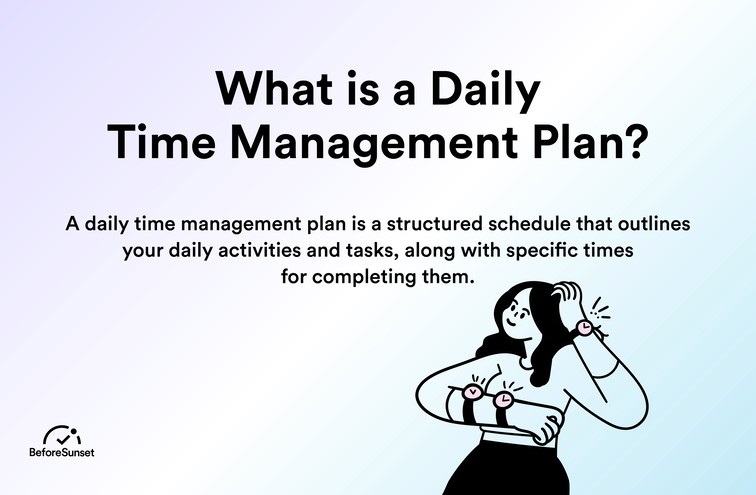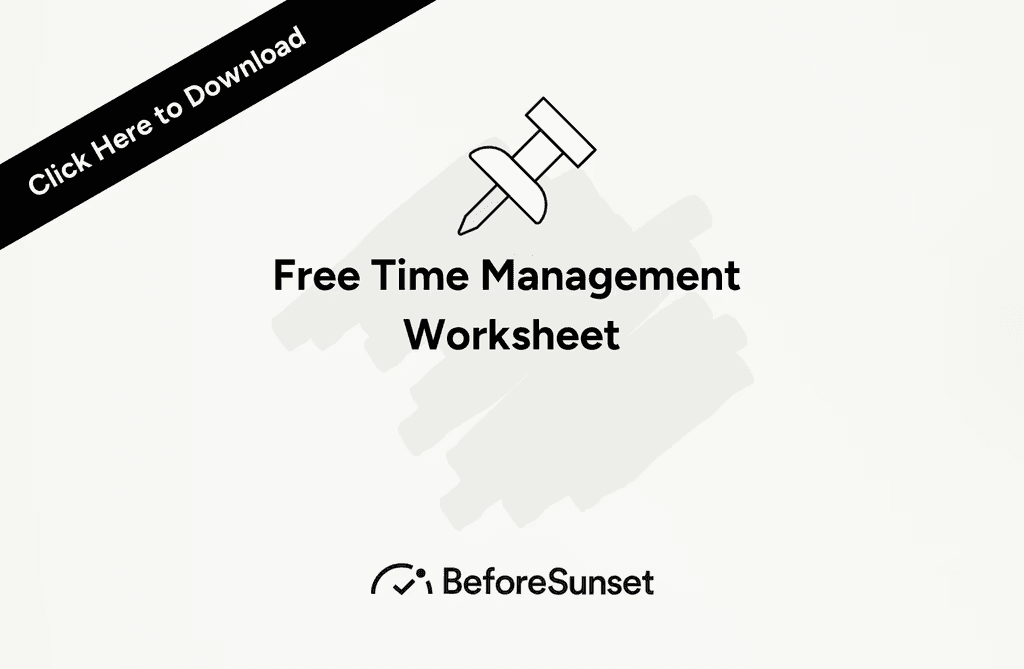Both students and employees must master the vital skill of time management if they are to succeed. Those who are good at managing their time more productively, avoid procrastinating and prioritize their activities.
A time management worksheet might be a helpful tool in this process. This worksheet is intended to assist both students and employees in task organization, time management, and progress monitoring. People may more effectively manage their time and achieve their objectives by utilizing a time management worksheet.
We'll give readers of this blog a free time management worksheet they may use to hone their time management abilities. You can download it by clicking the blog cover.
What Is A Time Management Worksheet?
A time management worksheet is a tool used to help individuals track and manage their time effectively. It typically consists of a table or chart that outlines specific time intervals, such as hourly or daily increments, and allows individuals to input tasks, appointments, or activities they need to complete during those time slots.
The purpose of a time management worksheet is to help individuals prioritize their tasks and make the most efficient use of their time. By having a visual representation of their schedule and tasks, individuals can better plan and organize their day, avoid overcommitting themselves, and ensure that important tasks are not overlooked.
Time management worksheets can take various forms, ranging from simple tables to more complex spreadsheets or software programs. Some worksheets may include additional features, such as color-coding, priority rankings, or goal setting, to further enhance their effectiveness. If you are an organization, check out how you can automate your employee timesheets.
You might also like:
How Can I Effectively Manage My Time?
Time management needs attention, prioritization, and preparation. Making a calendar or to-do list that describes the things you need to do and allots precise time periods to each one is one of the greatest strategies to manage your time successfully.
You can stay on task and refrain from procrastinating by doing this. To make sure that you focus on the most essential jobs first, it's also crucial to prioritize tasks according to their level of significance and urgency. Eliminating interruptions like social media or email notifications can also help you focus and be more productive.
Regular breaks can help you stay energized, increase productivity, and avoid burnout. Finally, it's critical to be adaptable and ready to change your schedule as necessary to make room for unforeseen circumstances or shifting priorities. You may successfully manage your time and accomplish your goals more quickly by using the techniques listed below.
What Are 5 Time Management Strategies?
Time management is important for a variety of reasons. First, efficient time management may boost your productivity and hasten the accomplishment of your goals. You may avoid wasting time on unimportant things and make the most of your time by prioritizing chores and scheduling specific activities.
Second, time management abilities may help you reduce stress and avoid burnout. Staying on top of work and avoiding last-minute rushes might help you minimize stress and feel more in control of your schedule.
Lastly, effective time management can assist you in achieving a better work-life balance. Good time management will help you to juggle work and personal duties without feeling stressed or overburdened.
Here are 5 time management strategies that can help you manage your time better and create a work life balance:

Prioritization
A crucial time management technique called prioritization includes identifying activities and rating them according to their significance and urgency. By setting task priorities, you can make sure that you focus on the most essential things first and prevent spending time on low-priority or unnecessary chores.
The first step in properly prioritizing activities is to make a list of every work that needs to be done. After you have a thorough list of tasks, you may rate the urgency and priority of each one. Priority should be given to jobs that are both important and urgent, then tasks that are both important and urgent, and finally chores that are neither important nor urgent. The final thing to do is to work on or even skip over things that are neither urgent nor crucial.
By setting priorities, you may stay focused on the most crucial activities and prevent procrastinating. Also, you may lower your stress levels and prevent last-minute rushes by completing crucial activities early. Ultimately, setting priorities is a crucial time management technique that may increase your productivity, help you accomplish your goals more quickly, and lower your stress levels.

Delegation
Delegation is a time-management technique that entails giving other people responsibility or job assignments. By utilizing the talents and knowledge of others, delegation may strengthen your team and free up your time so you can concentrate on more essential responsibilities.
It's crucial to recognize activities that may be delegated and to choose people who have the knowledge and experience necessary to accomplish them properly if you want to assign jobs successfully. To guarantee that the assignment is finished to your satisfaction, it is also crucial to offer clear directions and assistance.
By giving yourself more time for more crucial chores or projects, delegation may increase productivity. Also, it may develop a spirit of cooperation and teamwork among your team members and help you gain their trust.
Delegation is not always feasible or suitable, though, so it's vital to keep that in mind. To guarantee that jobs are finished to your satisfaction, it might be essential to execute some of them yourself. Also, it's crucial to refrain from assigning activities that are essential to your position or that need for your particular skill set or knowledge.
Eliminating Distractions
A time management technique called distraction reduction includes locating possible sources of distraction and reducing or eliminating them. Distractions have a negative effect on productivity, which can result in lost time and missed deadlines.
Start by recognizing the typical sources of distraction in your workplace in order to successfully eradicate them. Social media, email notifications, pointless meetings, and interruptions from coworkers may all fall under this category. After the causes of your distractions have been located, take action to reduce or get rid of them. For instance, you may disable notifications on your computer or smartphone, shut tabs or programs that aren't essential, or arrange blocks of undisturbed work time.
Setting limits with coworkers and colleagues is essential for preventing disruptions during crucial work hours. Setting fixed hours for meetings or appointments is one way to do this, as is wearing headphones to show that you are paying attention to your task.
By removing distractions, you can maintain your concentration, increase your productivity, and make the most of your time. You may work more successfully and efficiently while lowering your stress levels by reducing interruptions and avoiding pointless diversions.
Regular Breaks
Frequent breaks are a time-management technique that entails taking quick, organized breaks throughout the working day. You may improve attention, increase productivity, and lower stress levels by taking pauses.
Start by arranging brief breaks throughout the day to successfully integrate frequent breaks into your workplace. This can involve taking a little break of 5 to 10 minutes per hour or a longer break, like a 30-minute lunch break. It's crucial to rest and recharge during your breaks by doing things like going for a walk, reading a book, or practicing mindfulness.
You can retain focus and attention and increase your overall productivity by taking regular breaks. By giving you a chance to step away from work-related responsibilities and recharge both physically and emotionally, it can also assist you in lowering your stress levels. In fact, studies have shown that regular breaks can lessen burnout and increase overall job satisfaction.
It is crucial to remember that breaks should be deliberate and scheduled, not exploited as a justification for putting off work or becoming distracted. You may increase your productivity, enhance your general wellbeing, and make the most of your time by scheduling frequent breaks into your workweek.

What Is A Daily Time Management Plan?
A timetable or plan that specifies how you will use your time each day is known as a daily time management strategy. The plan normally consists of a list of the activities or tasks you must do along with an estimate of the time required for each activity.
You may prioritize your responsibilities and make the most of your time by using a daily time management strategy. Start by making a list of all the jobs or activities you have to perform during the day in order to establish a daily time management strategy. Then, order the jobs according to significance and urgency, and calculate how long each one will take to accomplish.
Allocate precise time slots for each job after you've determined your priorities and tasks. When planning projects, it's crucial to be realistic and provide additional time in case of unforeseen delays or disruptions. Schedule frequent breaks as well to aid in maintaining attention and preventing burnout.
The use of a planner, calendar, or online scheduling tool can be used to build a daily time management strategy. At the conclusion of each day, review your plan to gauge your success and make any required modifications for the next. With a daily time management strategy in place, you can remain focused, organized, and productive all day long.
Weekly Time Management Log
You can track and control how you use your time over the week with the use of a weekly time management record. The log normally contains a list of all the activities and tasks you do each week, along with how much time you devote to each one.
Start by breaking up your day into blocks of time, such as 30- or 60-minute intervals, in order to produce a weekly time management journal. Make a list of all the things you have to do this week, along with an estimate of how long they will take. Make careful to list both personal and professional tasks.
Keep track of the real time it takes to accomplish each assignment as you perform them during the week. You may do this to compare your anticipated time to the actual time and modify your timetable going forward.
Review your time management journal at the end of the week to evaluate your productivity and pinpoint areas where you may make improvements. Find any chores or activities that are taking up more time than is required by looking for patterns or trends in how you spend your time.
You can find areas where you could be squandering time or where you might be more productive by using a weekly time management journal. Also, it may guarantee that you are making the most of your time and that you remain accountable for and focused on your goals.

Daily Time Management Log
You can track and control how you use your time during the day with the use of a daily time management journal. The log normally contains a list of all the activities and tasks you do each day, along with how long you spend on each one.
Start by breaking up your day into blocks of time, such as 30-minute or 60-minute intervals, in order to produce a daily time management journal. Then, make a list of all the things you have to do today, along with an estimate of how long they will take.
Keep track of the real time it takes to finish each activity as you do them throughout the day. You may do this to compare your anticipated time to the actual time and modify your timetable going forward.
Review your time management diary at the end of the day to evaluate your productivity and find areas where you may make improvements. Find any chores or activities that are taking up more time than is required by looking for patterns or trends in how you spend your time.
Taking Control of Your Time: Mastering the Art of Time Management
Time. It's a constant, yet it often feels like it's slipping through our fingers. We juggle daily activities, long-term goals, and everything in between. But what if there was a way to harness the power of time and make it work for you? Enter the world of time management!
Crafting Your Master Plan
Effective time management starts with a plan. Here's your toolkit:
Daily Planner Template: This is your central hub. It can be a physical notebook, a digital app, or even a simple list – whatever works for you.
Long-Term Goals: What are you striving for? Break down those big dreams into manageable goals with clear deadlines.
Task List: This is where your daily to-dos come into play. Prioritize tasks using a system that works for you, like the Eisenhower Matrix (urgent/important) or the ABC method (priority levels).
Event Deadlines: Don't miss a beat! Mark important dates and deadlines in your planner to stay on track.
Budget Details: Don't forget about your time budget! Allocate specific time slots for tasks to ensure you're not overcommitting.
Powerful Tools for Everyday Use
Technology can be your time management BFF:
Interactive Tools: Explore online planners, to-do list apps, and time tracking software to find what boosts your internal efficiency.
Dynamic Documents: Utilize tools like cloud-based spreadsheets to manage budgets (both time and financial!) and project details, including hire documents (if applicable).
The Flexible Approach
Life doesn't always follow a script. Your time management strategy needs to adapt:
Flexible Items: Schedule buffer periods in your day to accommodate unexpected tasks or energy dips.
Open-Ended Deadlines: For less urgent tasks, set a daily goal (e.g., "work on X project for 30 minutes") instead of a strict deadline.
Energy Levels: Be your own boss! Schedule demanding tasks for when your energy is highest.
Class Time (if applicable): Block out dedicated time slots for attending classes and completing homework to ensure you stay on top of your academic schedule.
Beyond Efficiency: The Impact of Time Management
Time management isn't just about getting more done; it's about living a more fulfilling life. Here's how:
Reduced Stress: Feeling overwhelmed? Time management helps you tackle tasks efficiently, reducing anxiety and stress.
Improved Focus: By prioritizing and planning, you can avoid distractions and dedicate focused time to important tasks.
Work-Life Balance: Ever feel like work is taking over? Time management helps you allocate time for both professional and personal pursuits.
Goal Achievement: Breaking down large goals into manageable steps makes them more achievable, boosting your confidence and motivation.
Taking the First Step
Feeling overwhelmed by the sheer number of things you need to do? Start small! Choose one or two time management techniques from this blog and experiment. Remember, consistency is key. By taking control of your time, you'll be amazed at how much you can accomplish and how much more fulfilled you feel.
So, ditch the feeling of being constantly behind and take charge of your time! With a little planning, the right tools, and an effective strategy, you can unlock the power of time management and live a life that's both productive and enjoyable.
Conquering Chaos: A Multi-Template Approach to Time Management
Feeling overwhelmed by a looming deadline tsunami and a to-do list that resembles a grocery store receipt? You're not alone. Mastering workload and time management requires a strategic approach and the right tools.
Template Time!
Templates are your secret weapon in the war against disorganization. Here's where to start:
Time Management Templates: Choose a daily, weekly, or monthly format – whatever helps you visualize your workload. These templates can act as your to-do list template, with space for daily activities, key action items, and high priority items.
Team Goals Templates: Collaborate effectively with a shared team goals template. This ensures everyone is aligned on longer-term goals, measurable goals, and key action items.
Activity Templates: Need a breakdown for a specific project? Create an activity template that outlines tasks, deadlines (including tight deadlines and more flexible ones), and resource allocation.
Checklist Templates: Streamline repetitive tasks with a checklist template. From social media templates to client onboarding, checklists keep you on track.
Time Card Templates: Track your time accurately with a time card template. This is crucial for analyzing your workload and identifying areas for improvement.
Goal Setting for Success:
Effective time management hinges on setting the right goals:
Personal Goals & Monthly Goals: Identify your aspirations – from learning a new skill to nailing that promotion. Break down longer-term goals into manageable monthly goals.
Attainable Goals & Ambitious Goals: Balance is key. Set attainable goals to build confidence, but also push yourself with ambitious goals to keep things exciting.
Unfulfilled Goals: Don't let past misses hold you back! Analyze why some goals fell short and adjust your approach for the future.
Taming Tight Deadlines
Feeling crushed by dozens of deadlines? Here's how to fight back:
Four-Year Template: For long-term projects, a four-year template (or adjust based on your project timeframe) helps you visualize milestones and plan strategically.
Prioritize Mercilessly: Not all deadlines are created equal. Use a time management template to categorize deadlines by tight deadlines and more flexible ones. Focus on high-priority tasks first.
Remember: Time management is a skill, not a magic trick. Experiment with different templates (including social media templates if applicable) and goal-setting techniques to find what works best for you. By taking control of your workload and utilizing the right tools, you'll be amazed at how much you can accomplish. So, ditch the chaos and embrace a world of organized productivity!
Free Time Tracking Worksheet
You can download your free time tracking worksheet by clicking the cover image. We hope this worksheet is helpful.
BeforeSunset AI: A Mindful Approach to Time Management
Feeling like there just aren't enough hours in the day? You're not alone. Juggling work, personal commitments, and self-care can leave us all scrambling. But what if there was a tool that took the stress out of time management and helped you create a schedule that works for you? Enter BeforeSunset AI– a mindful productivity tool designed to empower individuals to be their best planners.
Time-Blocking Made Easy
BeforeSunset AI ditches the one-size-fits-all approach. Instead, it embraces the power of time-blocking. This technique lets you schedule specific blocks of time for dedicated tasks, ensuring you stay focused and avoid distractions.
Two Ways to Block:
AI Assistant: This handy feature takes the wheel, automatically generating a daily schedule based on your tasks and preferences.
Manual Control: Prefer a hands-on approach? No problem. BeforeSunset AI lets you build your schedule manually, seamlessly integrating with your existing calendar for a unified workflow.
Track Your Progress
Knowledge is power. BeforeSunset AI's built-in time-tracking feature allows you to monitor how much time you spend on each task. This valuable data helps you identify areas for improvement and optimize your schedule for maximum efficiency.
Unleash Your Inner Analyzer
Want to become a master planner? BeforeSunset AI's Personal Analytics screen provides insightful data about your productivity habits. Track your productivity score and gain valuable insights to continuously improve your time management skills.
More Than Just a Tool
BeforeSunset AI goes beyond basic scheduling. The integrated AI Assistant acts as your productivity partner, automatically creating actionable tasks, subtasks, and even suggesting ways to streamline your workflow. It's like having a personal time management guru at your fingertips!
Time Management, Reimagined
BeforeSunset AI breaks away from rigid scheduling apps. It focuses on the human aspect of productivity, empowering you to create a personalized and mindful approach to managing your time. So ditch the overwhelm and embrace a more fulfilling workday with BeforeSunset AI. Take control of your schedule, boost your productivity, and become the best planner you can be.

